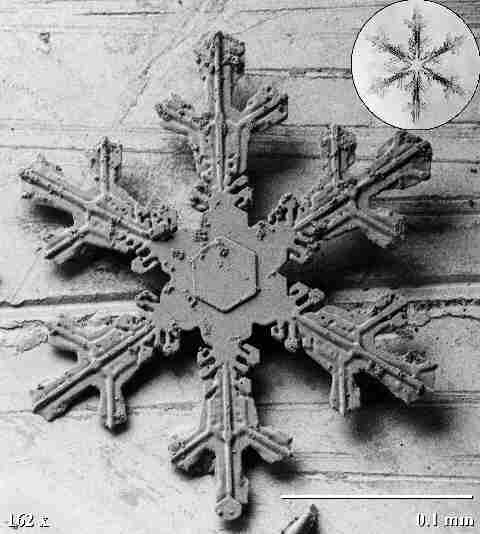- Mountain snowpacks are best characterized by digging snowpits in
order
to measure changes in physical properties of the snowpack (temp,
density,
stratigraphy...) with depth. For the next two questions, you will
compare
data collected from pits 006 and T3E on 14 March 1995. Pit 006 is a
snow
pit at a natural site on the saddle of Niwot Ridge. Pit T3E is behind a
snowfence, only 50 m from pit 006. The snowfence is part of a long-term
experiment to look at the effects of increased snow deposition on the
biology
and chemistry of an alpine tundra ecosystem. Please show all of the
work
for your answers. To find the data, go to http://niwot.colorado.edu/, under Data
select Data, then type Green Lakes Valley snow cover
profiles: Data Download.
- Calculate the depth-weighted mean density for each of the pits.
- Calculate the depth-weighted mean temperature for each of the
pits.
- Calculate the total snow water equivalence for each of the pits.
- note: the first and last rows of data for each snowpit
contain
only
the temperature at the snow/soil interface and at the snow surface
respectively.
- For the same snowpits (006 and T3E on 14 March 1995), graph a
temperature
profile and graph a density profile. The x-axis is either temperature
or
density, increasing from left to right. The y-axis is snow depth in
meters,
with 0 (the soil) at the bottom of the y-axis and the top of the y-axis
is the top of the snowpack. Density is the column "measured weight";
units
are grams/1000ml, which is the same as kg/m3. Temperature is the column
"measured temperature".
- Graph temperature from the two pits on the same graph.
- Graph density from the two pits together on another graph.
- In ten sentences or less, explain why the two pits have
different
density
and temperature values.
- Wind during snow events generally causes precipitation gauges to
undercollect
the "true" snowfall amount. The Niwot Ridge saddle area during the
winter
months is characterized by average wind speeds of about 10-13 m/s.
Further
up Niwot Ridge, the D1 meteorological site has much lower wind speeds.
Compare the annual precipitation amounts from Sdl and D1 to see if they
do in fact collect significantly different amounts of annual
precipitation.
Year Saddle D1
(year) (mm) (mm)
---- ---- ----
1986 1117 0908
1987 1790 1271
1988 1497 1055
1989 1827 1074
1990 1877 1037
1991 1269 1213
1992 1985 1502
1993 1544 1159
1994 2683 1568
1995 2955 1231
- Graph an XY scatter plot of Saddle (dependent variable) versus
D1
(independent)
annual precipitation.
- Regress Sdl ppt on D1 ppt using a linear relationship. Include
the line
equation and r2 values on the graph. Is there a significant
relationship
between precipitation measurements at the two sites on an annual
timescale?
- Test to see if annual Sdl ppt is significantly different than
D1 ppt
using
a paired t-test at the 0.05 probability level.
- Following is a small data set on wind speed and catch ratio of
snowfall
from Niwot Ridge. Graph wind speed (x axis) versus catch ratio on the
y-axis.
Explain these results in 5 sentences or less.
Wind Catch
Speed Ratio
(m/s) (fraction)
---- ----
1.6 1.00
1.75 0.91
2.5 0.59
2.7 0.58
8.2 1.23
- The precipitation amount measured by a precipitation gauge can be
adjusted
for blowing snow using the following equations:
Pa = K * Pg
Pa = adjusted precipitation
Pg = gauge-measured precipitation
K = 1/CR, adjustment factor for wind-induced error
CR = catch ratio of the gauge
CR = alter shield and snow = exp (0.0055-0.133Ws)
CR = no shield and snow = exp (-0.251-0.176Ws)
Ws = Wind speed (m/s) at gauge opening
CR = HAS NO UNITS, SINCE WE ARE CALCULATING A RATIO
note: exp(x) = ex
- Assume 50 mm of precipitation for the following questions:
- What is Pa for Ws = 0; alter shield and snow?
- What is Pa for Ws = 2; alter shield and snow?
- What is Pa for Ws = 10; alter shield and snow?
- What is Pa for Ws = 10; no alter shield and snow?
 SNOW
HYDROLOGY (GEOG 4321/5321): HOMEWORK ASSIGNMENT 3
SNOW
HYDROLOGY (GEOG 4321/5321): HOMEWORK ASSIGNMENT 3  SNOW
HYDROLOGY (GEOG 4321/5321): HOMEWORK ASSIGNMENT 3
SNOW
HYDROLOGY (GEOG 4321/5321): HOMEWORK ASSIGNMENT 3